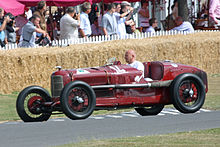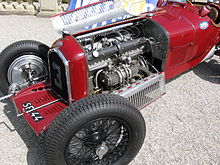Vittorio Jano
Vittorio Jano (born April 22, 1891 in San Giorgio Canavese , † March 13, 1965 in Turin ) was an Italian automobile designer, particularly of racing cars.
Life and professional performance
His parents immigrated to Italy from Hungary a few years before he was born . His father worked as technical director at the Turin railway workshops. At the age of 18 Jano began his professional career as a draftsman for the small car manufacturer Società Torinese Automobili Rapid . In 1911 he moved to the then well-known automobile manufacturer Fiat , where he was promoted to head of department under the direction of Carlo Cavalli.
On the mediation of Enzo Ferrari he switched to Alfa Romeo in 1923 . This happened together with his friend and colleague Luigi Bazzi, who was a test driver at Fiat. As chief engineer, he succeeded Giuseppe Merosi . In a few months he developed the Alfa Romeo P2 , which won numerous races from 1924 . The successors were the Alfa Romeo P3 as well as the 6C 1500 and the 8C , which were extremely successful on many racetracks. A particular success was the victory of the German Grand Prix in 1935 at the Nürburgring , when Tazio Nuvolari competed against the highly-favored Auto Union and Mercedes-Benz with an already outdated P3 . The Alfetta Tipo 158 racing cars built at the end of the 1930s , which were successful in the World Cup after the Second World War , were also based on his design.
The racing cars developed by Jano had a lasting impact on the sporty image of the Alfa Romeo brand. For the road, he developed vehicles with four- , six- and eight-cylinder in - line engines . Common features of these engines were two overhead camshafts , hemispherical combustion chambers and the use of cast aluminum connections . Even decades later, these were typical design features of a sporty Alfa Romeo engine.
In 1937 there was a dispute with the company director Ugo Gobbato, whereupon Vittorio Jano left the company. He then worked as a technical manager for Lancia . The racing cars he designed, Lancia D24 and Lancia D50 , were used for the first time in the early 1950s. After his top driver Alberto Ascari had a fatal accident during test drives with a Ferrari sports car and since his company was facing massive financial difficulties, Gianni Lancia decided to withdraw from racing and handed over the Formula 1 racing department to Ferrari . Jano, who also moved, became a consulting engineer at Ferrari. There he developed the "Dino" V6 and V8 machines, which became the technical basis for Ferrari's later successful series.
Like Enzo Ferrari, Jano lost his son in 1965. In the same year he fell seriously ill and committed suicide from a pistol shot.
Web links
Individual evidence
- ^ Vittorio Jano. motorsportmemorial.org, accessed on March 14, 2016 (English).
- ↑ People: Vittorio Jano. grandprix.com, accessed March 14, 2016 .
- ^ Noto progettista di auto da corsa si uccide con un colpo di pistola. La Stampa , March 14, 1965, accessed March 14, 2016 (Italian).
| personal data | |
|---|---|
| SURNAME | Jano, Vittorio |
| BRIEF DESCRIPTION | Italian racing car designer |
| DATE OF BIRTH | April 22, 1891 |
| PLACE OF BIRTH | San Giorgio Canavese ( TO ) |
| DATE OF DEATH | March 13, 1965 |
| Place of death | Turin |

